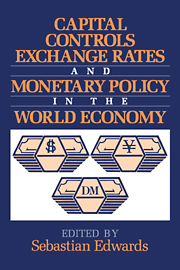Book contents
- Frontmatter
- Contents
- List of contributors
- Introduction
- Part I Monetary policy and stabilization in open economies
- Part II Capital mobility and macroeconomic policy in Europe
- 4 The lessons of European monetary and exchange rate experience
- 5 Experience with controls on international capital movements in OECD countries: solution or problem for monetary policy?
- 6 Real exchange rates and capital flows: EMS experiences
- 7 Monetary policy after German unification
- Part III Capital controls and macroeconomic policy in the Asia-Pacific region
- Part IV Capital mobility and exchange rates in Latin America
- Index
5 - Experience with controls on international capital movements in OECD countries: solution or problem for monetary policy?
Published online by Cambridge University Press: 16 October 2009
- Frontmatter
- Contents
- List of contributors
- Introduction
- Part I Monetary policy and stabilization in open economies
- Part II Capital mobility and macroeconomic policy in Europe
- 4 The lessons of European monetary and exchange rate experience
- 5 Experience with controls on international capital movements in OECD countries: solution or problem for monetary policy?
- 6 Real exchange rates and capital flows: EMS experiences
- 7 Monetary policy after German unification
- Part III Capital controls and macroeconomic policy in the Asia-Pacific region
- Part IV Capital mobility and exchange rates in Latin America
- Index
Summary
Introduction
Whether, and to what extent, to remove controls on international capital flows is a key strategic question for Korea and other countries in the Pacific Basin where economic capacities are advancing rapidly and where institutions are being transformed in other spheres. A large and still growing literature has developed around the experiences and situations of the more advanced developing economies. With Korea and some other countries in the Pacific Basin coming to resemble more closely the affluent market-oriented countries of the Organization for Economic Cooperation and Development (OECD) in economic productivity and institutions, the experiences of this group of countries and the lessons to be learned from them have become more relevant. During the 1950s and 1960s the OECD countries employed capital controls extensively and as a matter of routine as policy instruments in the conduct of monetary policy. Beginning in the 1970s, governments began to dismantle these controls. Today, few controls remain and nowhere in the OECD do they play a central role in monetary policy.
This chapter reviews the experiences of OECD countries, which has culminated in liberalized capital markets and a general recognition that, while not without problems, an open money and capital market is the best institutional setting for sustained monetary stability. Section 2 of the paper provides an overview of the use of capital controls in OECD countries from 1945 to the present.
- Type
- Chapter
- Information
- Publisher: Cambridge University PressPrint publication year: 1995
- 2
- Cited by



